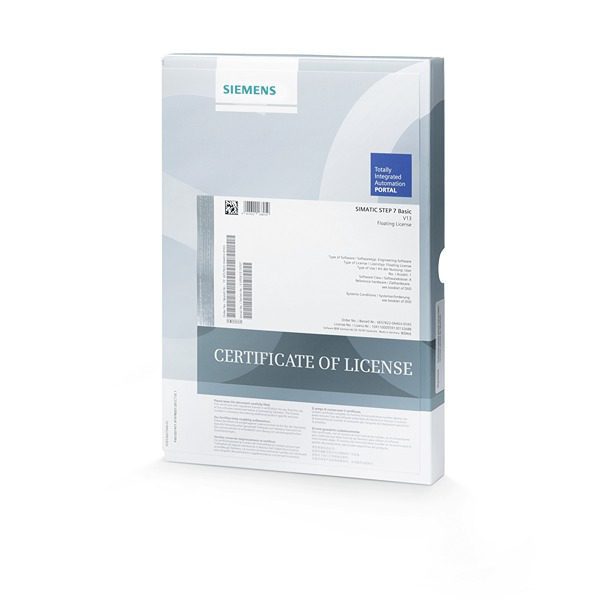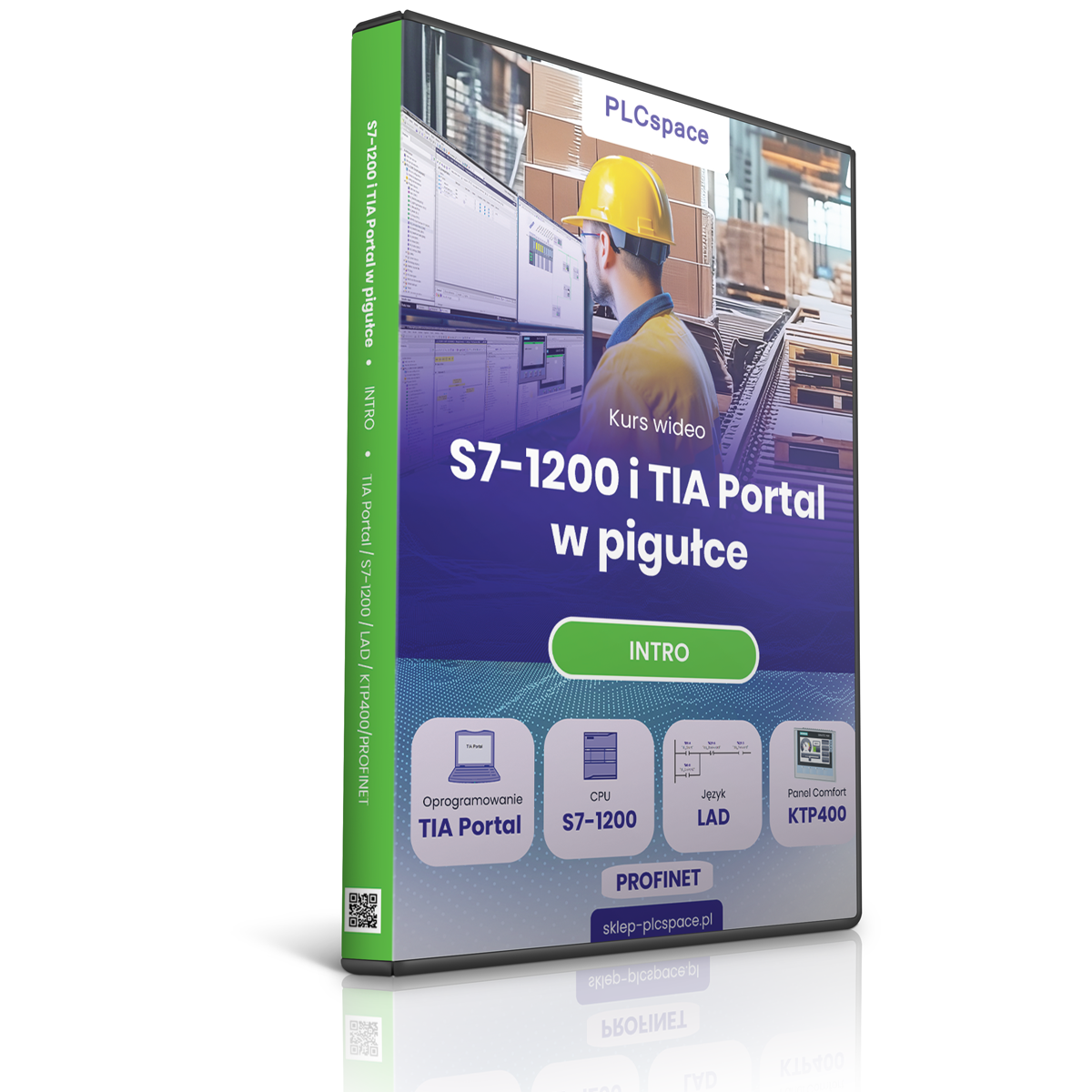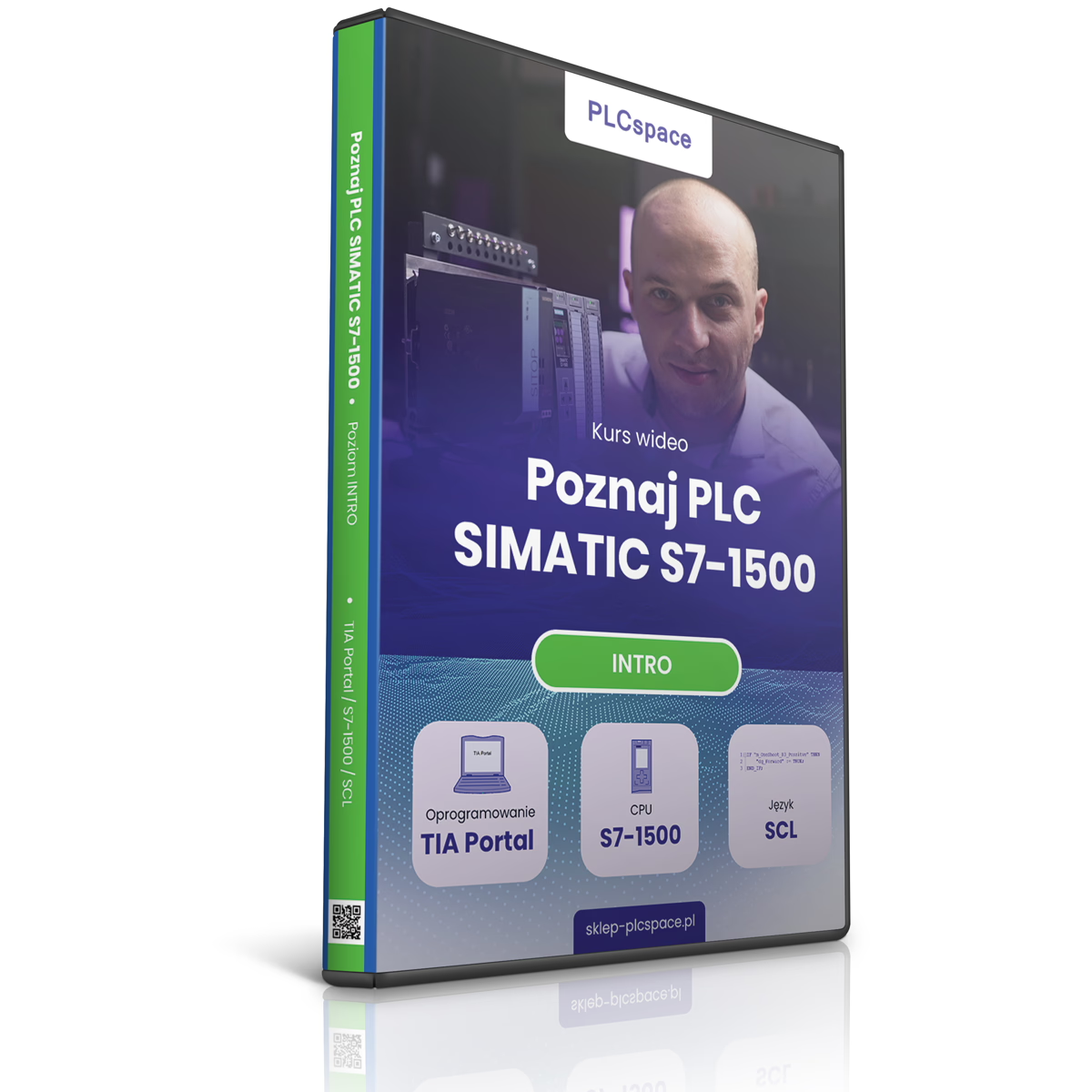Straight to the point with SIMATIC S7-1500
- Level:
The development environment used in the course
- Software:
Core unit family used in the course
- CPU:
A set of rules that are used to develop programme code
- Language:
Frequency converter (inverter) family used in the course
- Drive
479.00 zł – 499.00 zł
What do you get when you enrol on a PLC programming course?
Our SIMATIC S7-1500 PLC programming course in SCL language is a modern video formula that will allow you to adapt the pace of learning to your own preferences. We have also enriched it with special learning aids that will make it much easier for you to learn PLC programming. With this flexibility, you will achieve learning success whatever your schedule.
Siemens PLC S7-1500 programming course. TIA Portal basic level
You've probably heard a lot about Siemens S7-1500 PLC programming, especially during your schooling. Your lecturers pointed out that knowing the basics of PLC programming is indispensable if you plan a professional future in automation. The problem, however, is that once you have acquired the theoretical basics of Siemens PLC programming, there is very little left in your memory once you receive your diploma, and even less in practice.
If you want to gain practical controller programming knowledge that will open the door to your dream career, you are in the right place. Check out our course that will allow you to master the Simatic S7-1500 in a TIA environment like a true professional.
What is the Siemens Simatic PLC course about?
Our training in PLC basics is tailored for people:
- Without previous experience in the area of PLCs and the programming environment.
- Having some basics of operating a Siemens Simatic S7-1500 PLC and wanting to gain practical knowledge.
PLC knowledge is applicable in many professional fields related to industrial automation. Whether you are a learner, a student or a beginner in automation, our PLC programming course is for you.
Currently, Siemens Simatic S7-1500 PLC logic controllers can be programmed in five languages. Our training focuses on learning the SCL language, which is considered flexible and versatile.
Our offer includes the use of TIA Portal software, a free programming tool for Siemens controllers. For the first 21 days you do not need any licence and the software has full functionality. This is sufficient time to complete your programming training.
If you're tired of spending hours on theoretical knowledge that doesn't translate much into practice, our Simatic S7 PLC programming course is just for you. Start your Simatic S7 controller programming adventure today!
Knowledge test:
Is this course for you? Take this test MULTIPLE choice to check it out.
Egzamin Summary
0 of 9 Questions completed
Questions:
Information
You have already completed the egzamin before. Hence you can not start it again.
Egzamin is loading…
You must sign in or sign up to start the egzamin.
You must first complete the following:
Results
Results
0 of 9 Questions answered correctly
Your time:
Time has elapsed
You have reached 0 of 0 point(s), (0)
Earned Point(s): 0 of 0, (0)
0 Essay(s) Pending (Possible Point(s): 0)
Categories
- Not categorized 0%
- 1
- 2
- 3
- 4
- 5
- 6
- 7
- 8
- 9
- Current
- Review
- Answered
- Correct
- Incorrect
-
Question 1 of 9
1. Question
Which block type is the instance DB associated with?
CorrectIncorrect -
Question 2 of 9
2. Question
Global tags can be declared in:
CorrectIncorrect -
Question 3 of 9
3. Question
What types of blocks are available in the TIA Portal environment?
CorrectIncorrect -
Question 4 of 9
4. Question
Is it possible that on the online preview (e.g. in the programme code) and on the preview in the Watch table the state of the output will differ ?
CorrectIncorrect -
Question 5 of 9
5. Question
What operation does the := operator perform
CorrectIncorrect -
Question 6 of 9
6. Question
Which organisational block is executed during a manual restart of the S7-1200 controller ?
CorrectIncorrect -
Question 7 of 9
7. Question
Is it possible to change the program code language from LAD to SCL and vice versa ?
CorrectIncorrect -
Question 8 of 9
8. Question
Can program code written in SCL be monitored (viewed during execution) ?
CorrectIncorrect -
Question 9 of 9
9. Question
Are the SR and RS manuals available in SCL?
CorrectIncorrect
Key information about the course
You will find that you will be eager to reach for more material yourself. You will find that PLC programming does not have to be boring and clichéd. In our course, you will not only learn the basics of logic controller programming, but also many creative solutions used by professionals. This will make your projects come alive.
With us, you will learn to look at the work of an automation-programmer holistically. You will find work both as a freelancer and as a member of teams: those large, corporate and small and specialised. We teach you to understand PLCs from the simplest basics, so after our course you will find yourself in any environment.
You will also learn how to avoid them. We will explain to you what design mistakes that happen to someone starting out with a PLC lead to and show you creative ways to design controllers efficiently and safely.
The virtual factory will show you the typical problems faced by automation engineers. With access to Factory I/O, you can inspect, test and experiment to your heart's content, so that you don't have to do this on the real job. In this way, you will learn in advance how to keep your colleagues safe.
Our course conveys good programming practices that will work for any business. We know that there are many ways to program, but we only teach those proven, safe and ethical methods. We have many years of practice and experience behind us. We are happy to share them with you.
Why should you choose this industrial automation course?
You will find more than one PLC training course on the market, but our course is a completely different tale. Why should you choose us?
Sample lesson / What you will do after the course
What is TIA's PLC training for beginners like?
The training consists of 5 parts divided into individual topics. Once you have completed all parts, you will know how to control PLC modules and use them in your daily work to improve the operation of your project. What information will you find in each part?
Once you have completed the Siemens PLC programming course, you can look for a job in a machine automation profession with confidence. Surprise your employer with your level of preparation and show them that you know and understand PLC operation inside out. You will find that even the best lectures are no substitute for a great practical course. Check out our courses today!
-
Module 1 - Downloading and installing the TIA Portal environment
- Registration on the Siemens website
- Which files to download
- Installation of TIA Portal software
- Installation of the PLCsim simulator
-
Module 2 - Downloading and installing the virtual factory - Factory IO
- Which files to download
- Installation of the Factory IO tool
-
Module 3 - Licences
- TIA Portal - TRIAL licence activation
- TIA Portal - activation of full licence (floating type)
- Factory IO - TRIAL licence activation
- Factory IO - Full licence activation
-
Module 1 - Introduction
-
- Introduction
- What is a programming language?
- Division of programming languages
- LAD language
- FBD language
- STL language
- GRAPH language
- SCL language
- Where to use the SCL language ?-
- SIMATIC S7-1500
- S7-1500 automation system
- SIMATIC system
- SIMATIC S7-1500
- Components
- S7-1500 versions
- Overview
- Rail mounting
- Power connection
- Mounting the module in the cradle
- Programmer
- Online connection
- PC configuration
- TIA Portal
- Checking available equipment on the network
- Diagnostics
- Creation of the project
- Switching the TIA Portal view
- Adding a device
- Unknown PLC - classic S7-1500
- Unknown PLC - ET200sp CPU
- Unknown PLC
- Connection type with PLC
- Choice of PLC interface
- Autodetection
- Hardware configuration
- Addressing of modules
- Symbolic names
- Programme blocks
- Writing programme code
- Addition of new block OB1
- Insertion of instructions
- Compilation
- Compilation result
- Download
- Load preview window
- Load results window
- Programme code monitoring
- Monitoring of tags (symbolic names)
- Watch tables
- Diagnostics -
-
Module 2 - First project
- Actual PLC
- PLCsim simulator
- IO addressing
- Hello world - writing your first code
-
Module 3 - Bitwise operations
-
- Introduction
- Introduction
- General description
- AND - Logical product
- OR - Boolean sum
- XOR - Logical symmetric difference
- Negation of RLO
- NAND, NOR, NXOR
- Example
- Task-
- Example in TIA Portal
-
-
Module 4 - Conditional instructions
-
- IF, IF...ELSE, IF...ELSIF instructions
- General provision
- Conditional statement IF...THEN
- Conditional statement IF...THEN...ELSE
- Conditional statement IF...THEN...ELSIF
- Example
- Task
- Solution-
- Set - Reset
- Single setting and reset
- Dominance of setting and resetting
- Example
- Internship at TIA Portal-
- Example in TIA Portal
-
-
Module 5 - PLC variables
-
- Introduction
- Introduction
-
- Example in TIA Portal
- S7-1500 automation system
-
-
Module 6 - Memory
-
- Markers
- Available memory areas
- Absolute addressing of memory areas
- Absolute addressing in a data block
- Absolute addressing - example
- Creation of variables
- Use in programme code
- CPU memory usage overview
- Example
- Internship at TIA Portal
- Task
- Solution-
- Systematic
- System and Clock Memory
- Example
- Internship at TIA Portal
- Task
- Solution -
-
Module 7 - Slopes
- Rising slope
- How to write programme code
- Descending slope
- How to write programme code
- Example
- Task 1
- Solution
- Task 2
- Task 3
- Task 4
-
Module 8 - Data types
- Integer types
- Number systems
- Floating point types
- Floating point number representation
- Data types - example values
- Overview of types
- Data types in PLC tags
- Declaration and use
- Display format - Watch table
- Example
- Internship at TIA Portal
-
Module 9 - Conversion
- Available instructions
- Conversion function
- Overview of types and conversion options
- Rounding
- Task 1
- Solution
-
Module 10 - Arithmetic operations
- General provision
- Available operations - examples
- What should I pay attention to?
- Task 1
- Solution
- Internship at TIA Portal
-
Module 11 - Comparison operations
- General provision
- Available operations - examples
- Priorities for operations
- Task 1
- Solution
- Task 2
- Solution
-
Module 12 - FC functions
- Blocks - overview
- Linear VS modular programme
- User programme execution
- Addition of FC function
- View of the workspace
- Interface section
- Function call
- User programme execution
- Download
- Example - splitting the application into parts
- FC function code monitoring
- Reasons - No preview in FC block
- Cross reference
- Temporary variables
- Task
- Solution
-
Module 13 - Examples
- Example 1
- Example 2
-
Module 14 - Data blocks
- Places of use
- Addition of a new DB block
- Use of
- Preview
- Modification
- Task
- Solution
-
Module 15- Counters
- Data types for counter instructions
- Counter call - example
- CTU - Counting upwards
- CTD - counting down
- CTU D- Counting up and down
- Assigning values to parameters
- Task1
- Solution
- Task2
- Solution
- Task3
- Solution
-
Module 16 - Timekeeping
- Variable of type TIME
- Example
- Timer TP - Pulse generator
- TON timer - switch-on delay
- TOF timer - Switch-off delay
- TONR timer - time accumulator
- Task1
- Solution
- Internship at TIA Portal
- Task2
- Solution
- Task3
-
Module 1 - From A to B
- Task
- Solution
-
Module 2 - Queue of item
- Task
- Solution
Software and hardware used

CPU S7-1500
They are available in the classic and et200sp housing. The SIMATIC S7-1500 is a modular automation system with medium and higher performance. Different controller versions allow you to match the corresponding application. Depending on requirements, the programmable controller can be expanded with input/output modules for digital and analogue signals, as well as technology and communication modules.

TIA Portal software
Totally integrated automation is a development environment that combines PLC (programming), HMI(visualisation) and startdrive(drive technology).

Factory IO
Typical machine scenarios can be run in Factory IO, and the virtual factory connects to the SIM PLC simulator (or the actual PLC. Programming of the controller is possible in the programming environment (depending on the PLC family), and insight into its operation is available during the online connection
What will you be able to do after completing the course?
The skills you gain from the course will prove useful in a wide variety of professions. Those listed below are just a few of the areas in which you can find employment as a graduate:
The current education system focuses solely on dry discussion of theoretical issues, while offering no opportunity to understand them through practical examples. Yet it is the latter that employers value most. The aim of our training is to offer ready-made solutions that will help the trainee to do better in the job market - programming experience is not required!


Guarantee
and certificate
If, after 14 days of purchase, you find that it is not for you, I will refund 100% of the course price. Upon completion of the course, you will receive a certificate in two languages - Polish and English.

Frequently asked questions
-
Will I receive a confirmation after my purchase?
Yes, you receive an email. Sometimes emails end up in SPAM or other folders. Please check your mailbox carefully.
-
Is there a difference between the media on which the course can be ordered?
No. The material is the same regardless of the type of storage medium. At the time of purchase, you decide which type of data carrier you choose, i.e. online, DVD or USB.
-
Which PLC programming language should I choose when starting out?
If you are an electrician then LAD. If there has been any exposure to text-based languages (C, C++, C#, Java, etc) then SCL. If there has been no exposure to any programming at all then the basic course is LAD and SCL (the solution to each task is shown in two languages).
-
Is this course for me if I have never used a PLC?
Yes. The basic courses are just set up so that people with no exposure to Siemens PLCs can learn such skills. The student is guided step by step (as can also be seen in the course table of contents).
-
What tools are used for consultation?
Consultations take place via Skype or TeamViever.
-
How do I make an appointment for a consultation?
Please send an email to biuro@plcspace.pl with your questions (problems) and suggestions for a convenient date for your consultation (via Skype or Teamviever).
-
How long are the consultations valid?
This is 60 calendar days from the date of purchase.
-
Can I deliver the course on different computers?
Yes. The course material (videos) can be viewed on any computer.
-
What does the online version of the course look like?
You receive the course by email, where there are private links to the videos.
-
What if a problem arises during the course?
Please email me with a description of the problem at: biuro@plcspace.pl.
-
What is the access time for the course?
No time limits for any medium (i.e. online, DVD or USB version).
-
Do I need to have any experience with programming?
No. The basic course gives step-by-step all the information needed from 'scratch'.
-
Will I need to purchase a licence for the Factory IO software?
No. There is information in the course on how to obtain licences to complete the material.
-
Will I need to purchase a licence for the PLC development environment?
No. There is information in the course on how to obtain licences to complete the material.
-
Is it possible to return the course?
Yes.
-
Will I need a PLC to deliver the course?
No. A real controller is not necessary. The course is designed in such a way that it can also be completed on a virtual controller. It all depends on what the trainee has at their disposal.
-
How do I buy a course?
Just click Add to basket and complete the form and make payment.
-
When does the course start?
-> Online version - immediately after payment
-> Physical version - when you receive the package from the carrier.
Buy as a set and save
Select at least 2 courses from the list and the first free book item (three selections in total) and an automatic discount of 25% will be calculated in your basket.
If you want to find out more about a particular course, click on its name and the page will take you to its offerings.
Companies that have benefited from our courses




































Feedback from students
 Stanislaw
Stanislaw
What sets this course apart is the opportunity to acquire practical, concrete knowledge. Everything is clearly explained. Definitely recommended!
 Marcel
Marcel
After going through the course, I know what the components of the programming environment are and what to do step by step. Now I feel confident and know what I am doing
 Leon
Leon
Course delivered in a very accessible way. Contains a lot of interesting and useful information.
 Michael
Michael
I can honestly recommend the course. It is solid and factual knowledge. I will definitely be buying more.
 Victor
Victor
Thanks to the course, I have decided to go further in this direction. The goal is to look for a more challenging and better job
 Peter
Peter
The course prepared by Mr Tomasz is distinguished by its high level of content and meticulously prepared lessons. They are planned in a clear and sensible manner, making it easier to assimilate knowledge and return to the material if necessary. An additional advantage is the possibility of a free consultation.
 Nikodem
Nikodem
Definitely recommended! The facts themselves, no unnecessary dwelling on issues.
 Ignatius
Ignatius
This is my first course, certainly not my last. I am impressed with the substantive quality of the knowledge.
 Tymon
Tymon
Everything clearly explained, you can really learn a lot. Lots of practical information and examples to help you remember everything. In my opinion, it is worth using this form of learning because you can learn anytime and anywhere. It is practical and convenient.
You may also be interested in:
- Level:
The development environment used in the course
- Software:
Core unit family used in the course
- CPU:
A set of rules that are used to develop programme code
- Language:
Frequency converter (inverter) family used in the course
- Drive
1.199.00 zł 497.00 zł
- Level:
The development environment used in the course
- Software:
Core unit family used in the course
- CPU:
A set of rules that are used to develop programme code
- Language:
Frequency converter (inverter) family used in the course
- Drive
39.00 zł
- Level:
The development environment used in the course
- Software:
Core unit family used in the course
- CPU:
A set of rules that are used to develop programme code
- Language:
Frequency converter (inverter) family used in the course
- Drive
499.00 zł 299.00 zł
- Level:
The development environment used in the course
- Software:
Core unit family used in the course
- CPU:
A set of rules that are used to develop programme code
- Language:
Frequency converter (inverter) family used in the course
- Drive
499.00 zł 49.00 zł





